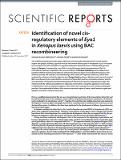| dc.contributor.author | Maharana, Santosh Kumar | |
| dc.contributor.author | Pollet, Nicolas | |
| dc.contributor.author | Schlosser, Gerhard | |
| dc.date.accessioned | 2017-11-08T16:22:34Z | |
| dc.date.available | 2017-11-08T16:22:34Z | |
| dc.date.issued | 2017-11-03 | |
| dc.identifier.citation | Maharana, Santosh Kumar, Pollet, Nicolas, & Schlosser, Gerhard. (2017). Identification of novel cis-regulatory elements of Eya1 in Xenopus laevis using BAC recombineering. Scientific Reports, 7(1), 15033. doi: 10.1038/s41598-017-15153-7 | en_IE |
| dc.identifier.issn | 2045-2322 | |
| dc.identifier.uri | http://hdl.handle.net/10379/6960 | |
| dc.description.abstract | The multifunctional Eya1 protein plays important roles during the development of cranial sensory organs and ganglia, kidneys, hypaxial muscles and several other organs in vertebrates. Eya1 is encoded by a complex locus with candidate cis-regulatory elements distributed over a 329 kbp wide genomic region in Xenopus. Consequently, very little is currently known about how expression of Eya1 is controlled by upstream regulators. Here we use a library of Xenopus tropicalis genomic sequences in bacterial artificial chromosomes (BAC) to analyze the genomic region surrounding the Eya1 locus for enhancer activity. We used BAC recombineering to first create GFP reporter constructs, which were analysed for enhancer activity by injection into Xenopus laevis embryos. We then used a second round of BAC recombineering to create deletion constructs of these BAC reporters to localize enhancer activity more precisely. This double recombineering approach allowed us to probe a large genomic region for enhancer activity without assumptions on sequence conservation. Using this approach we were able to identify two novel cis-regulatory regions, which direct Eya1 expression to the somites, pharyngeal pouches, the preplacodal ectoderm (the common precursor region of many cranial sensory organs and ganglia), and other ectodermal domains. | en_IE |
| dc.description.sponsorship | We are very grateful to Zbynek Kozmik for his generous help in establishing BAC recombineering. We also thank Robert Grainger for plasmids and Margaret Fish for technical advice. Santosh Kumar Maharana was supported by a Hardiman Fellowship of NUI Galway and Fellowship GOIPG/2013/472 from the Irish Research Council (IRC). | en_IE |
| dc.format | application/pdf | en_IE |
| dc.language.iso | en | en_IE |
| dc.publisher | Nature Publishing Group | en_IE |
| dc.relation.ispartof | Scientific Reports | en |
| dc.rights | Attribution-NonCommercial-NoDerivs 3.0 Ireland | |
| dc.rights.uri | https://creativecommons.org/licenses/by-nc-nd/3.0/ie/ | |
| dc.subject | Novel cis-regulatory elements | en_IE |
| dc.subject | Eya1 | en_IE |
| dc.subject | Xenopus laevis | en_IE |
| dc.subject | BAC recombineering | en_IE |
| dc.title | Identification of novel cis-regulatory elements of Eya1 in Xenopus laevis using BAC recombineering | en_IE |
| dc.type | Article | en_IE |
| dc.date.updated | 2017-11-08T14:42:54Z | |
| dc.identifier.doi | 10.1038/s41598-017-15153-7 | |
| dc.local.publishedsource | http://dx.doi.org/10.1038/s41598-017-15153-7 | en_IE |
| dc.description.peer-reviewed | peer-reviewed | |
| dc.contributor.funder | |~| | |
| dc.internal.rssid | 13418990 | |
| dc.local.contact | Gerhard Schlosser, Department Of Zoology, Biosciences Research Building, Newcastle Road, Galway. 5978 Email: gerhard.schlosser@nuigalway.ie | |
| dc.local.copyrightchecked | No | |
| dc.local.version | ACCEPTED | |
| nui.item.downloads | 1214 | |


